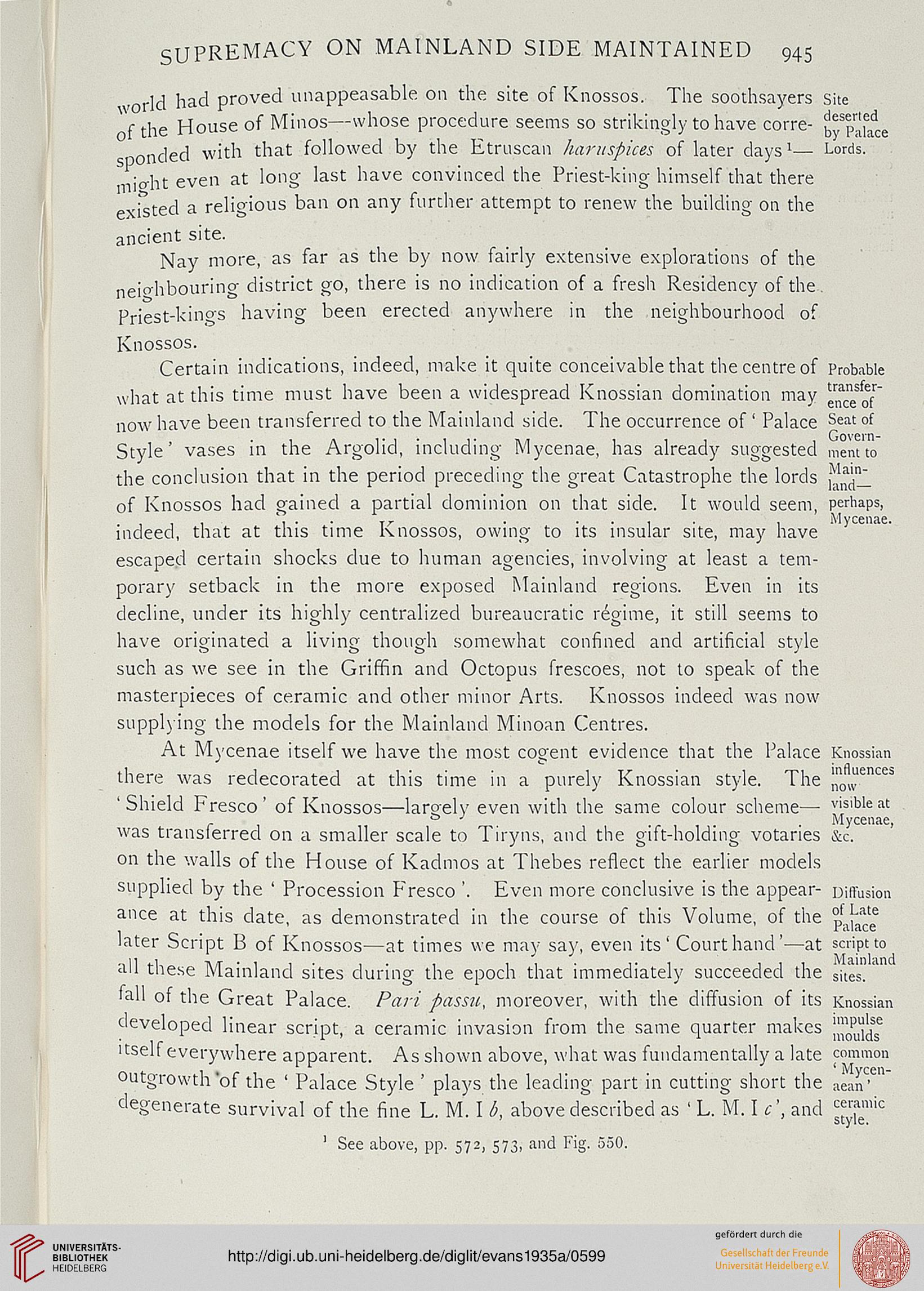SUPREMACY ON MAINLAND SIDE MAINTAINED 945
rid had proved unappeasable on the site of Knossos. The soothsayers site
f the House of Minos—whose procedure seems so strikingly to have corre- j^^
onded with that followed by the Etruscan haruspices of later days'— Lords,
jo-ht even at long last have convinced the Priest-king himself that there
existed a religious ban on any further attempt to renew the building on the
ancient site.
Nay more, as far as the by now fairly extensive explorations of the
neighbouring district go, there is no indication of a fresh Residency of the.
Priest-kino's having been erected anywhere in the neighbourhood of
Knossos.
Certain indications, indeed, make it quite conceivable that the centre of Probable
what at this time must have been a widespread Knossian domination may "™fot~
now have been transferred to the Mainland side. The occurrence of' Palace Seat of
Style' vases in the Argolid, including Mycenae, has already suggested mem to
the conclusion that in the period preceding the great Catastrophe the lords JJ^l
of Knossos had gained a partial dominion on that side. It would seem, perhaps,
, . . . rr . .... , Mycenae,
indeed, that at this time Knossos, owing to its insular site, may have
escaped certain shocks due to human agencies, involving at least a tem-
porary setback in the more exposed Mainland regions. Even in its
decline, under its highly centralized bureaucratic regime, it still seems to
have originated a living though somewhat confined and artificial style
such as we see in the Griffin and Octopus frescoes, not to speak of the
masterpieces of ceramic and other minor Arts. Knossos indeed was now
supplying the models for the Mainland Minoan Centres.
At Mycenae itself we have the most cogent evidence that the Palace Knossian
there was redecorated at this time in a purely Knossian style. The ,J0„ue
'Shield Fresco' of Knossos—largely even with the same colour scheme— visible at
. . Mycenae,
was transferred on a smaller scale to Tiryns, and the gift-holding votaries &c.
on the walls of the House of Kadmos at Thebes reflect the earlier models
supplied by the ' Procession FTesco '. Even more conclusive is the appear- Diffusion
ance at this date, as demonstrated in the course of this Volume, of the p^jjj?
later Script B of Knossos—at times we may say, even its' Court hand'—at script to
all these Mainland sites during the epoch that immediately succeeded the sites.'
fall of the Great Palace. Pari passu, moreover, with the diffusion of its Knossian
developed linear script, a ceramic invasion from the same quarter makes ™pu"dse
itself everywhere apparent. As shown above, what was fundamentally a late common
outgrowth'of the ' Palace Style ' plays the leading part in cutting short the aean'
degenerate survival of the fine L. M. I b, above described as ' L. M. I c', and |;™™c
1 See above, pp. 572, 573, and Fig. 550.
rid had proved unappeasable on the site of Knossos. The soothsayers site
f the House of Minos—whose procedure seems so strikingly to have corre- j^^
onded with that followed by the Etruscan haruspices of later days'— Lords,
jo-ht even at long last have convinced the Priest-king himself that there
existed a religious ban on any further attempt to renew the building on the
ancient site.
Nay more, as far as the by now fairly extensive explorations of the
neighbouring district go, there is no indication of a fresh Residency of the.
Priest-kino's having been erected anywhere in the neighbourhood of
Knossos.
Certain indications, indeed, make it quite conceivable that the centre of Probable
what at this time must have been a widespread Knossian domination may "™fot~
now have been transferred to the Mainland side. The occurrence of' Palace Seat of
Style' vases in the Argolid, including Mycenae, has already suggested mem to
the conclusion that in the period preceding the great Catastrophe the lords JJ^l
of Knossos had gained a partial dominion on that side. It would seem, perhaps,
, . . . rr . .... , Mycenae,
indeed, that at this time Knossos, owing to its insular site, may have
escaped certain shocks due to human agencies, involving at least a tem-
porary setback in the more exposed Mainland regions. Even in its
decline, under its highly centralized bureaucratic regime, it still seems to
have originated a living though somewhat confined and artificial style
such as we see in the Griffin and Octopus frescoes, not to speak of the
masterpieces of ceramic and other minor Arts. Knossos indeed was now
supplying the models for the Mainland Minoan Centres.
At Mycenae itself we have the most cogent evidence that the Palace Knossian
there was redecorated at this time in a purely Knossian style. The ,J0„ue
'Shield Fresco' of Knossos—largely even with the same colour scheme— visible at
. . Mycenae,
was transferred on a smaller scale to Tiryns, and the gift-holding votaries &c.
on the walls of the House of Kadmos at Thebes reflect the earlier models
supplied by the ' Procession FTesco '. Even more conclusive is the appear- Diffusion
ance at this date, as demonstrated in the course of this Volume, of the p^jjj?
later Script B of Knossos—at times we may say, even its' Court hand'—at script to
all these Mainland sites during the epoch that immediately succeeded the sites.'
fall of the Great Palace. Pari passu, moreover, with the diffusion of its Knossian
developed linear script, a ceramic invasion from the same quarter makes ™pu"dse
itself everywhere apparent. As shown above, what was fundamentally a late common
outgrowth'of the ' Palace Style ' plays the leading part in cutting short the aean'
degenerate survival of the fine L. M. I b, above described as ' L. M. I c', and |;™™c
1 See above, pp. 572, 573, and Fig. 550.




